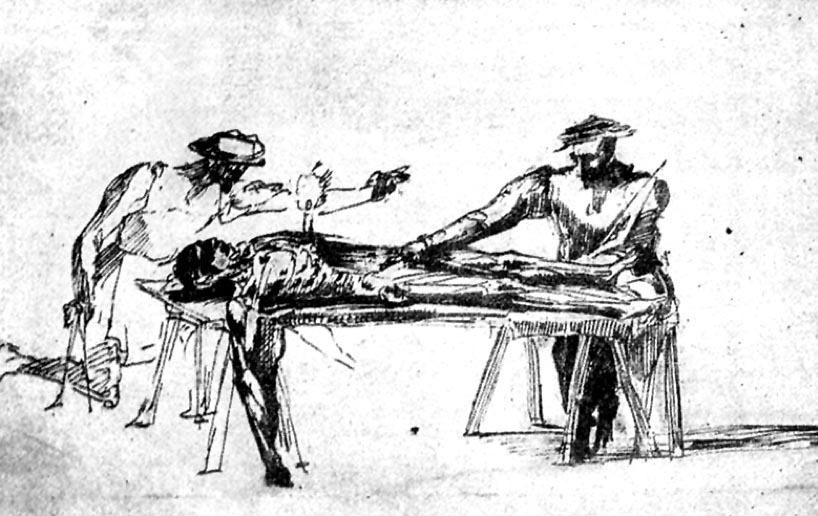Kotsanas’ wooden reproduction of the stomachion

Kotsanas’ wooden reproduction of the stomachion A modern reproduction of Archimedes’ stomachion Copyright: Collection and Archive of Kotsanas Museum of Ancient Greek Technology (www.kotsanas.com) – The image shows a reproduction of the stomachion game located in the K. Kotsanas Museum of Ancient Greek Technology in Heraklion, Crete. This wooden artefact consists of a square geometric […]
The geometric design of the stomachion diagram

The geometric design of the stomachion diagram The division of the square according to the indications of an Arabic manuscript description: stomachion of Archimedes, with a 1/12 grid, author: Hagen von Eitzen, copyright: public domain – This image reproduces the Graeco-Roman stomachion square according to the proportions provided by a 17th c. manuscript in the […]
The Gut / Der Darm

The Gut / Der Darm Anetta Mona Chisa & Lucia Tkacova public sculpture, Schillerplatz, Chemnitz (part of the project Gegenwarten | Presences), photographed by the artist – The Gut is the organ that renders Marx’s body in the city that holds the largest sculpture of Marx’s head in the world – Karl-Marx-Monument. The actual head […]
Henry Gray (anatomist) and Henry Vandyke Carter (artist), Fig. 1005, Superior and inferior duodenal fossæ.

Henry Gray (anatomist) and Henry Vandyke Carter (artist), Fig. 1005, Superior and inferior duodenal fossæ. Gray’s Anatomy Descriptive and Applied. A New American Edition (1913), p. 1265.Private collection: Nina Sellars. Photographer: Nina Sellars. – Giving thoughtful attention to the physical qualities of the classical anatomical atlases brings our awareness not only to their content and […]
John Sloan, A self-portrait of the artist holding a cup of barium and undergoing an upper gastrointestinal fluoroscopic study under the care of two radiologists, 1926.

John Sloan, A self-portrait of the artist holding a cup of barium and undergoing an upper gastrointestinal fluoroscopic study under the care of two radiologists, 1926. Medium: etching and aquatint. Collection: National Library of Medicine. – Anatomy is a science predominantly based on visual observation. Therefore, the anatomical body’s existence is seemingly reliant on modes […]
Bernardino Capitelli, Anatomical Dissection, c. 1604 – 1639.

Anatomical Dissection, 1495-approximately 1543 Two men studying a corpse by the light of a candle stuck in itschest. Etching after a drawing attributed to Polidoro Caldara (Polidoro da Caravaggio). Wellcome Collection. Attribution 4.0 International (CC BY 4.0) – In the Renaissance era, the tempo and sequence of a dissection were dictated by the decomposition rate […]
Andreas Vesalius (anatomist) and Jan van Calcar (artist), studio of Titian. The Seventh Plate of Muscles.

Andreas Vesalius (anatomist) and Jan van Calcar (artist), studio of Titian. The Seventh Plate of Muscles. Illustration from the second edition of the anatomy text De humani corporis fabrica (On the Fabric of the Human Body), 1555, p. 230. Medium: woodblock print made by unknown block cutter. Metropolitan Museum of Art, New York, Gift of […]
Dancer Shona Dunlop performing the role of Cain in Cain and Abel, Sydney, Australia, 1940.

Dancer Shona Dunlop performing the role of Cain in Cain and Abel, Sydney, Australia, 1940. Choreographer: Gertrud Bodenwieser. Composer: Marcel Lorber. Medium: gelatin silver photograph. Photographer: Margaret Michaelis. Collection: Hocken Library Collection at University of Auckland. – Shona Dunlop was born in Ōtepoti, Aotearoa (Dunedin, New Zealand), and studied with choreographer and dancer Gertrud Bodenwieser […]
LHS 4a: A Qing period manuscript illustration of the Yuanmen maijue neizhao tu 元門脈訣內罩圖

A B Travelling guts A A Qing period manuscript illustration of the Yuanmen maijue neizhao tu 元門脈訣內罩圖 (Internal Visualisation Charts from the ‘Primordial Portal’ Secret Art of the Pulse), attr. Hua Tuo, 3rd century CE. This chart shows the position of Qi Hai (the Sea of Qi, the diaphragm).Library of China Academy of Chinese Medical […]
SET 3a-f Kim Yemong et al. Ui’bang’ryuchui 醫方類聚, vol. 5, pp. 51-70

A D B E C F SET 3a-f Kim Yemong et al. Ui’bang’ryuchui 醫方類聚, vol. 5, pp. 51-70 (original edition in Kyoto Palace, Japan; microfilm copy in National Library, Korea) Attribution 4.0 International (CC BY 4.0) – Chinese ideas about the images of the animal spirits, here of the lungs, the heart, the liver, the […]
